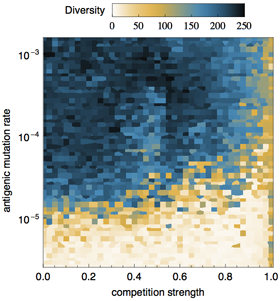We just had a new paper published in PLoS Pathogens lead by graduate student Daniel Zinder that addresses antigenic evolution in the influenza virus. Generally, what sets the pace of antigenic evolution in influenza has remained something of a mystery. There is massive pressure for the virus to evolve to escape human immunity. However, dramatically new variants (ones that necessitate a vaccine update) only emerge every year or three. In this study, we wanted to find out whether the emergence of new influenza variants is limited by waiting for new, advantageous, mutations to appear or whether emergence is limited by waiting for immunological circumstances to change in the human population.
In a very simple model with only a few epitopes determining the virus’s antigenic phenotype, we find that a low mutation rate is critical to reproducing influenza’s observed level of genetic diversity; immunological pressures alone will not result in restricted diversity. This is seen in the accompanying figure, in which low diversity outcomes (shown in white) only occur at very low mutation rates. However, we do find that a rather amazingly simple model with just a few epitopes does a pretty decent job at reproducing observed influenza dynamics.
For me, this research suggests that more work is needed to understand the effects of changing the dimensionality and size of the antigenic space in which a virus evolves. Does limiting flu to just a few epitopes improve model fits/predictions? Does it matter how many variants exist at each epitope site? Does it matter how mutation moves from variant to variant, i.e. are all variants of an epitope site reachable by a single mutational event?
